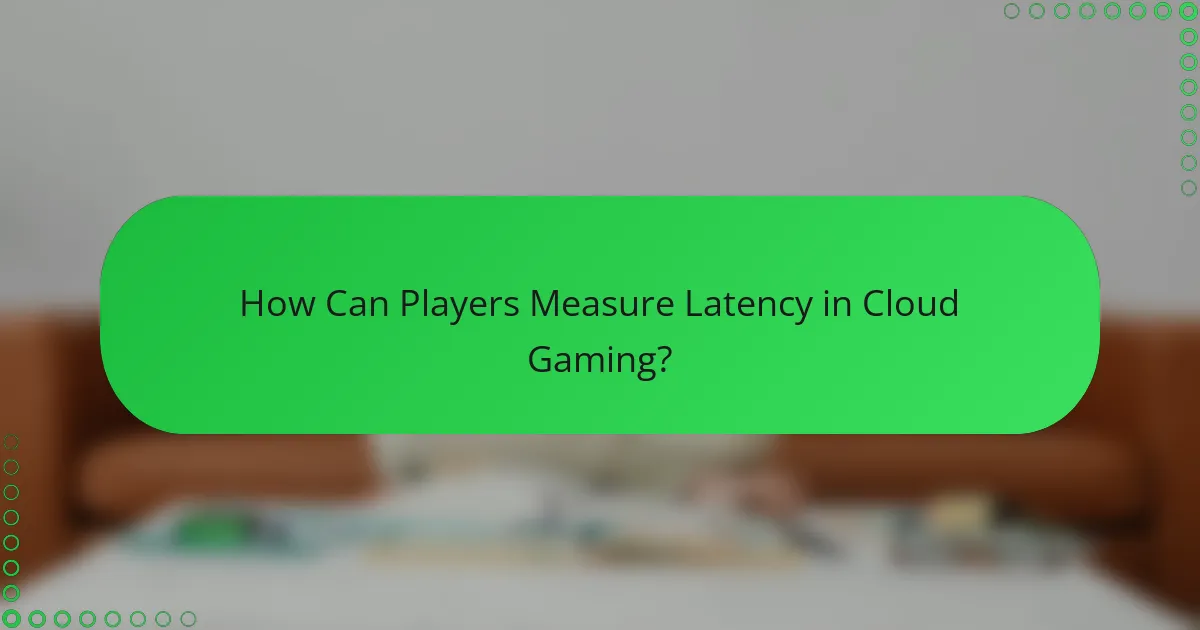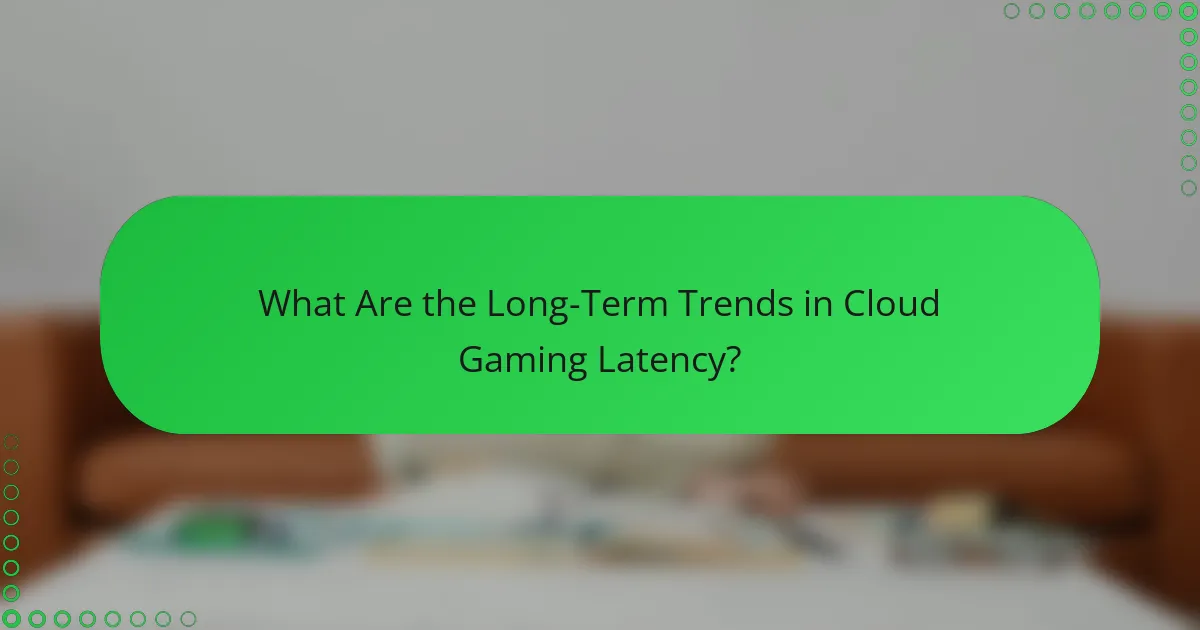Latency plays a crucial role in competitive cloud gaming, as even minor delays can severely affect player performance and enjoyment. High latency results in slower reaction times and can create a frustrating experience, particularly in fast-paced games where precision is key. To mitigate these issues, players can optimize their network settings and choose low-latency servers, which is essential for achieving the best streaming stability for multiplayer gaming. For more insights on this topic, check out our guide on Streaming Stability for Multiplayer Gaming.
 Understanding latency is vital for players, and for more detailed information, you can explore our insights on Cloud Gaming Performance Metrics.
Understanding latency is vital for players, and for more detailed information, you can explore our insights on Cloud Gaming Performance Metrics.
How Does Latency Affect Competitive Cloud Gaming?
Latency significantly impacts competitive cloud gaming by introducing delays that can hinder player performance and overall game experience. High latency can lead to slower reaction times, decreased game performance, and a frustrating experience for players, especially in fast-paced competitive environments.
Impact on reaction times
Reaction times are critical in competitive gaming, where split-second decisions can determine the outcome of a match. Latency introduces delays between a player’s input and the game’s response, often measured in milliseconds. Even a latency of 20-50 ms can be noticeable, while anything above 100 ms can severely impair a player’s ability to react quickly.
Players should aim for latency below 30 ms for optimal performance. To minimize latency, using wired connections instead of Wi-Fi and choosing servers closer to their location can help reduce delays.
Influence on game performance
Game performance is directly affected by latency, as it can disrupt the smoothness of gameplay and lead to issues like lag or stuttering. High latency can result in frame drops and inconsistent game mechanics, making it difficult for players to execute strategies effectively. This is particularly detrimental in competitive scenarios where precision is essential.
To enhance game performance, players should regularly check their internet speed and ensure they meet the recommended bandwidth for cloud gaming, typically around 15-25 Mbps for a stable experience. Additionally, optimizing game settings to reduce graphical demands can help maintain performance under varying latency conditions.
Effects on player experience
The overall player experience in cloud gaming is heavily influenced by latency. High latency can lead to frustration, decreased enjoyment, and a sense of disconnect from the game. Players may feel that their actions are not being accurately represented in the game, which can diminish their competitive edge and motivation to play.
To improve player experience, gamers should seek platforms with lower latency options and consider using services that offer dedicated servers. Engaging with communities to share tips on optimizing setups can also enhance the overall gaming experience, making it more enjoyable and competitive.

What Are Effective Strategies to Reduce Latency?
To effectively reduce latency in cloud gaming, players should focus on optimizing their network settings, selecting low-latency servers, and using wired connections. Implementing these strategies can significantly enhance the gaming experience by minimizing delays and improving responsiveness.
Optimizing network settings
Optimizing network settings involves adjusting configurations on your router and device to prioritize gaming traffic. This can include enabling Quality of Service (QoS) settings, which allocate more bandwidth to gaming applications, reducing lag during play.
Additionally, consider changing the DNS settings to a faster provider, which can improve connection speeds and reduce latency. Popular options include Google DNS or Cloudflare DNS, both of which are known for their speed and reliability.
Choosing low-latency servers
Selecting low-latency servers is crucial for minimizing delays in cloud gaming. Look for servers that are geographically closer to your location, as this typically results in lower ping times. Many gaming platforms allow players to choose their server region during setup.
It’s also beneficial to check community feedback or server performance metrics to identify which servers consistently offer the best latency. Opting for dedicated gaming servers over shared ones can further enhance performance.
Using wired connections
Using wired connections instead of wireless can significantly reduce latency in cloud gaming. Ethernet connections provide a more stable and reliable signal, minimizing interruptions and fluctuations that often occur with Wi-Fi.
If a wired connection is not feasible, ensure that your Wi-Fi network is optimized by placing the router in a central location and minimizing interference from other devices. Consider upgrading to a dual-band router to take advantage of less congested frequencies.

Which Cloud Gaming Platforms Offer the Best Performance?
The best-performing cloud gaming platforms balance low latency, high resolution, and consistent frame rates. Key players like NVIDIA GeForce NOW, Google Stadia, and Xbox Cloud Gaming each have unique strengths that cater to different gaming needs.
NVIDIA GeForce NOW
NVIDIA GeForce NOW excels in delivering high performance with low latency, making it a top choice for competitive gamers. It leverages powerful server hardware and allows users to stream games they already own on various digital platforms.
To optimize your experience, ensure a stable internet connection with speeds of at least 15 Mbps for 720p and 25 Mbps for 1080p. Using a wired connection can further reduce latency compared to Wi-Fi.
Google Stadia
Google Stadia offers a seamless gaming experience with impressive graphics and minimal latency, particularly for users with strong internet connections. It supports 4K streaming at 60 frames per second, which can enhance competitive play.
However, Stadia requires a subscription and may not support all titles available on other platforms. Players should check game availability and ensure their internet speed meets the recommended 35 Mbps for optimal performance.
Xbox Cloud Gaming
Xbox Cloud Gaming, part of Xbox Game Pass, provides access to a wide library of games with decent performance. While it may not match the ultra-low latency of GeForce NOW, it offers a user-friendly experience for casual and competitive gamers alike.
For the best results, aim for a minimum of 10 Mbps for 720p and 20 Mbps for 1080p streaming. Players should also consider using an Xbox controller for improved compatibility and responsiveness during gameplay.

What Are the Key Factors Influencing Latency?
Several factors significantly influence latency in cloud gaming, impacting the overall experience for competitive play. The most critical elements include geographical distance from servers, internet speed and stability, and hardware specifications.
Geographical distance from servers
The physical distance between a player and the cloud gaming server is a major contributor to latency. Generally, the farther away the server is, the higher the latency, often measured in milliseconds (ms). For competitive gaming, a distance of over 1000 kilometers can lead to noticeable delays.
To minimize latency, players should select servers that are geographically closer to their location. Many cloud gaming platforms allow users to choose their server region, which can significantly enhance responsiveness during gameplay.
Internet speed and stability
Internet speed and stability are crucial for maintaining low latency in cloud gaming. A high-speed connection, typically above 15 Mbps for streaming, helps ensure smooth gameplay. However, fluctuations in speed can lead to spikes in latency, disrupting the gaming experience.
Players should aim for a wired connection over Wi-Fi whenever possible, as this tends to provide a more stable and reliable internet connection. Regularly testing internet speed and monitoring for any interruptions can help identify potential issues before they affect gameplay.
Hardware specifications
The hardware used for cloud gaming also plays a role in latency. Devices with higher processing power and better graphics capabilities can handle data more efficiently, reducing the time it takes to render images and respond to inputs. This is particularly important in fast-paced competitive games.
Players should ensure their devices meet or exceed the recommended specifications for the cloud gaming service they are using. Investing in a good quality router and maintaining up-to-date hardware can significantly enhance the gaming experience by reducing latency.

How Can Players Measure Latency in Cloud Gaming?
Players can measure latency in cloud gaming by utilizing various tools and methods that provide insights into the delay between input and on-screen action. Understanding latency is crucial for competitive play, as even small delays can impact performance and gameplay experience.
Using built-in game tools
Many modern games come equipped with built-in tools that display latency metrics. These tools often show real-time data on ping and frame rates, allowing players to gauge their connection quality directly within the game environment.
To access these features, players can typically navigate to the game’s settings menu and enable network statistics. This can help identify if latency spikes occur during gameplay, which can be crucial for adjusting strategies in competitive scenarios.
Third-party latency testing tools
Third-party latency testing tools provide a more comprehensive analysis of network performance. Applications like PingPlotter or Speedtest can measure latency, packet loss, and jitter, giving players a clearer picture of their connection’s reliability.
When using these tools, players should conduct tests at different times of the day to account for variations in network traffic. A consistent latency reading below 50 ms is generally considered optimal for competitive gaming, while anything above 100 ms can lead to noticeable delays.

What Are the Long-Term Trends in Cloud Gaming Latency?
Long-term trends in cloud gaming latency indicate a gradual improvement in response times, driven by advancements in technology and infrastructure. As cloud gaming services evolve, they aim to reduce latency to enhance the competitive gaming experience.
Technological Advancements
Technological advancements play a crucial role in reducing latency in cloud gaming. Innovations such as edge computing, which processes data closer to the user, significantly decrease the time it takes for inputs to be registered. Additionally, improvements in internet speed and bandwidth are essential, with many providers now offering fiber-optic connections that can support low-latency gaming.
Infrastructure Development
Infrastructure development is another key factor influencing cloud gaming latency. Companies are investing in data centers strategically located near major population centers to minimize the distance data must travel. This geographical optimization can lead to latency reductions of several milliseconds, which is critical for competitive play.
Player Experience and Expectations
As cloud gaming technology improves, player expectations for latency continue to rise. Gamers now demand near-instantaneous response times, often below 30 milliseconds, to maintain a competitive edge. Services that fail to meet these expectations may struggle to retain users, emphasizing the need for continuous improvement in latency management.
Market Competition
In a competitive market, companies are under pressure to deliver the best possible gaming experience, including low latency. This competition drives innovation and investment in better technology and infrastructure. As more players enter the cloud gaming space, the focus on reducing latency will likely intensify, benefiting consumers through improved services.
